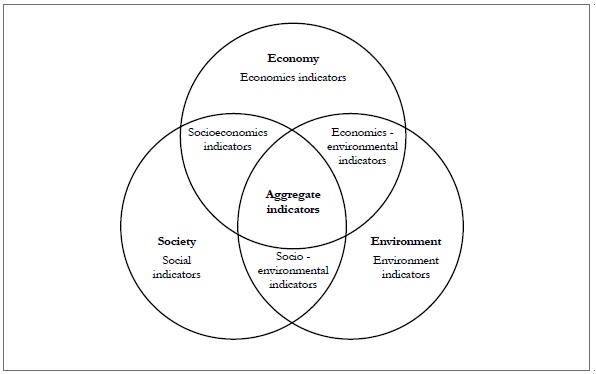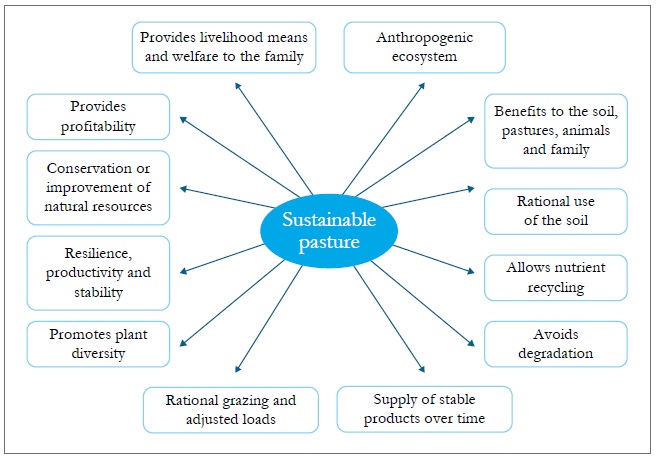Services on Demand
Journal
Article
Indicators
-
 Cited by SciELO
Cited by SciELO -
 Access statistics
Access statistics
Related links
-
 Cited by Google
Cited by Google -
 Similars in
SciELO
Similars in
SciELO -
 Similars in Google
Similars in Google
Share
Ciencia y Tecnología Agropecuaria
Print version ISSN 0122-8706On-line version ISSN 2500-5308
Cienc. Tecnol. Agropecuaria vol.20 no.2 Mosquera May/Aug. 2019
https://doi.org/10.21930/rcta.vol20num2art:1464
Manejo de sistemas productivos
Indicators associated to pastures sustainability: a review
1Investigador, Misión Verde Amazonia: Corporación para el Desarrollo Sostenible y Mitigación de Cambio Climático, Grupo GIEDES. Florencia, Colombia.
2Docente, Universidad de la Amazonia, Facultad de Ciencias Agropecuarias. Florencia, Colombia.
3Investigadora, Misión Verde Amazonia: Corporación para el Desarrollo Sostenible y Mitigación de Cambio Climático, Grupo GIMCCA. Florencia, Colombia.
4Corporación Colombiana de Investigación Agropecuaria - Corpoica
Pastures are anthropogenic ecosystems that offer lowcost food resources mainly for feeding ruminants, being the base for production and livelihoods in many rural areas worldwide. Pasturebased production is important for the social, environmental and economic implications where sustainability plays a prominent role because it meets both the needs of present and future generations. The aims of this review article were the following: to show the progress and application of the sustainability concept focused on pastures, and to relate indicators for the measurement of pasture sustainability in the tropics. This article describes the sustainability, the indicators for sustainability, the pastures in the humid tropics of the Amazon region, the sustainability applied to pastures, and finally, provides indicators and metrics to evaluate sustaina-bility in pastures. In conclusion, a sustainable pasture must provide benefits to the soil, the plants, and the animals, as well as provide livelihoods to the family that manages the system through appropriate management practices that allow the resilience of the pasture system and the conservation or improvement of natural resources for present and future generations.
Keywords agroforestry; livelihoods; livestock production; productivity; silvopastoral systems; sustainability
Las pasturas son ecosistemas antropizados que ofrecen recursos alimenticios de bajo costo, principalmente para la alimentación de rumiantes, siendo la base para la producción y los medios de vida en muchas zonas rurales del mundo. La producción basada en pasturas tiene importancia por las implicaciones sociales, ambientales y económicas. Aquí la aplicación de la sostenibilidad juega un papel destacado, porque permite satisfacer tanto las necesidades de las generaciones presentes como las de las futuras. Los objetivos del presente artículo de revisión fueron los siguientes: presentar el avance y la aplicación del concepto de sostenibilidad enfocado en pasturas, y relacionar indicadores para la medición de sostenibilidad en pasturas del trópico. Este artículo describe la sostenibilidad, los indicadores para la medición de la sostenibilidad, las pasturas en el trópico húmedo de la Amazonia, la sostenibilidad aplicada a las pasturas y, finalmente, los indicadores y las métricas para evaluar la sostenibilidad en pasturas. En conclusión, una pastura sostenible debe proporcionar beneficios al suelo, las plantas y los animales, así como proveer medios de vida a la familia gestora del sistema mediante prácticas de manejo adecuadas, que permitan la resiliencia del sistema de pastura y conserven o mejoren los recursos naturales para las generaciones presentes y futuras.
Palabras clave agroforestería; medios de vida; producción pecuaria; productividad; sistemas silvopascícolas; sostenibilidad
Introduction
Livestock production has a strong impact on natural resources such as water, biodiversity, soil, among others. Moreover, the surface of the forests worldwide has been reduced by more than 40 million hectares since year 2000, mainly through deforestation to establish new pastures (Sepúlveda, Ibrahim, Bach, & Rodríguez, 2011), covering more than 3.4 billion hectares (Mahecha, Gallego, & Peláez, 2002), which is equivalent to 33 % of the land of the entire planet ( Jose, Walter, & Kumar, 2017). In Latin America, pastures constitute the primary land use in extensive monoculture production systems, where more than 50 % of the area shows advanced stages of degradation that affect the sustainability of the system, and with a tendency of increasing the number of livestock producers (Sepúlveda et al., 2011).
Pastures are recognized for their contribution to the environment, recreation, and efficiency in milk and meat production, in which sustainability is crucial in the system to maintain profitability and a friendly environment, while producing high economic value food intended for human consumption (Shakoor, 2008).
A sustainable pasture is one in which, in the long term, the conditions of environmental quality and ecosystem resource base are improved, while providing food to satisfy human needs in an economically viable way and improving the life quality of producers and consumers (Sollenberger, 2008; Stewart, Lal, & El-Swaify, 1991). Sustainable production in agricultural systems is essential for human life since food will always be needed for the continuously growing population; therefore, it is necessary to take care of the soil and avoid its degradation or progressive desertification (Ramírez, Alvarado, Pujol, MaHugh, & Brenes, 2008).
The evaluation of sustainability has generally used a large number of indicators that focus on specific aspects of the economic, environmental and social dimensions; however, compiling everything related to sustainability can be reflected in the loss of information (Londoño, 2015). An indicator is a tool that allows obtaining information on a given reality, through the synthesis of a complete set of information, including conditions, processes and system behavior (Gamboa-Tabares et al., 2009a).
Sustainability can be measured partially or globally as a subsystem or as a system, respectively; hence, if a subsystem is unsustainable, so will the system that contains it (Fernández & Gutiérrez, 2013). In this sense, indicators are a tool for decision making at any scale, and their study must be done in a particular way, according to the conditions of each agroecosystem (García, Ramírez, & Sánchez, 2012).
The aims of this review article were the following: to show the progress and application of the sustainability concept focused on pastures, and to relate indicators for the measurement of pasture sustainability in the tropics.
Method
First, available scientific literature was consulted, including articles, books, conferences and theses from the first document published until 2017, using the databases Scopus, Springer Link, Science Direct, EBSCO host, Scielo and Google Scholar, and employing the following terms: sustainability, sustainable agroecosystem, sustainable pasture, and sustainable grassland. Moreover, consultations were held on sustainability indicators in pastures and agroecosystems, tropical pastures, pastures in the Amazon, as well as the main components of pastures destined for cattle production and the interaction of their components.
The criteria for the inclusion of the bibliography in the current revision were the following:
That the subject of the document is related to sustainability of agroecosystems or pastures.
That it shows sustainability indicators or evaluations in agroecosystems or pastures.
That it addresses issues related to the implementation, production or degradation of pastures in the Amazon.
Topic development
For this article, the term “sustainability” (sostenible in Spanish) was used instead of the term “supportable” (sustentable in Spanish), because despite the epistemological advances in its definition, the use of the second term to refer to the essence of economic, social and environmental well-being is ambiguous and has been misused many times. However, as described by Fernández and Gutiérrez (2013), the adequate term to address the issues concerning the social, economic and environmental well-being of present and future generations is “sustainable”, since the term “supportable” derives from an inadequate translation from English. The latter does not address the environmental and social deterioration that is generated, and cannot be considered synonymous, although in Latin America there is an indistinct use of both terms.
In this article, the term “indicator” refers to the quality or essential concept in the sustainability components, meanwhile the term “metric” on the other hand, refers to a specific property of the system that can be directly measured (Smith et al., 2017),i.e., it can be understood as a measurement variable.
In this review, we included 78 bibliographicalreferences of which 22 (28.21 %) were publishedbetween 2013 and 2017; 37 (47.44 %), between2008 and 2012, and 19 (24.36 %) were publishedbefore 2007. The predominant language of thereferences used is Spanish with 46 (58.97 %) articles,followed by English with 24 (30.77 %), and Portuguesewith 8 (10.26 %).
After consulting five different bibliographical bases (table 1) for all areas of knowledge, including all available publications (articles, books, and conferences) from the first document published until 2017, the average number of publications that mentioned sustainability is 214,857, which would represent 100 % within the entire sampling; however, despite the high volume of published material, only 7.96 % contains the term “sustainable” in the title. Nonetheless, it is more disconcerting that the term “sustainable agroecosystems” represent only 1.64 % and 0.004 % of the publications with the term “sustainability” contained in the document and in the title, respectively.
Table 1. Number of publications in scientific bibliographical bases on sustainability, sustainable agroecosystems, sustainable pastures and sustainable grasslands
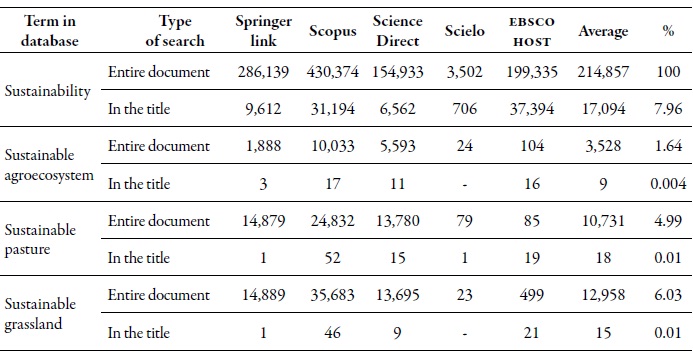
Source: Elaborated by the authors
The terms “sustainable pasture” and “sustainable grassland” used to refer to the sustainability of pastures are more frequent than expected in publications compared to the term “sustainable agroecosystem.” However, the numbers are not the best, since these terms only represent 0.01 % concerning publications on sustainability.
Sustainability concept
The concept of sustainability is a modern Western thinking current with ethical, political, environmental, economic and technological implications (Gamboa-Tabares et al., 2009b). In this sense, this concept was initially linked to a purely economic approach aiming at complementing it with environmental aspects (Espinola, Plá, Montañez, Leyva, & Cáceres, 2017). Consequently, due to the negative environmental, social and cultural impact of certain practices of modern agriculture, the need to change to a more sustainable model has been brought up (Sarandón & Flores, 2009).
There are different levels of analysis of the sustainability concept: it is very different to speak of a sustainable production system than of a sustainable ecosystem or a sustainable society (García, Bienvenido, & Flores, 2009), as a sustainable production system conserves land, water, plant and animal resources (agronomically efficient). Furthermore, it does not degrade the environment (environmentally adequate), it is technically appropriate, economically viable, socially fair, and is based on a holistic scientific method, in which the environment and its natural resources are the basis of the economic activity, guaranteeing the satisfaction of present and future human needs (Bonnefón, 2016; Dias-Filho, 2011). For Espinola et al. (2017) sustainability has three pillars or basic dimensions: environmental, social and economic (figure 1). For an activity to be sustainable, it must simultaneously fulfill several objectives, i.e., it must be environmentally, socially and economically sustainable over time. It cannot be considered sustainable if it meets certain aspects and fails in others, as sustainability per se is indivisible; therefore, the sustainability of the three pillars must converge (Casas-Cázares, González-Cossio, Martínez-Saldaña, García-Moya, & Peña-Olvera 2009; Rinehart, 2010; Sarandón & Flores, 2009; von Bernard, 2006).
Sustainability demands a new interpretation and adaptation of the territory to current human needs through proper management, i.e., first the environmental, economic, social, cultural and landscape resources must be known so they can then be used (Romero, 2009). Also, sustainability in agricultural systems is influenced by many biophysical, economic, social and political factors (Kroff, Bouma, & Jones, 2001), which must involve a reduction in external inputs and promote internal self-sufficiency (Tellarini & Caporali, 2000).
Sustainability measurement indicators
Indicators are instruments in decision and follow-up processes; besides, they are defined as parameters that identify and provide information, which can be qualitative or quantitative and that allows quantifying and simplifying a phenomenon or process (Sánchez-Fernández, 2009). Indicators are perceived as analytical instruments that facilitate the measurement of the changes through which a system goes through, as well as being tools that guide and make decisions about how to use natural, economic and social resources (García et al., 2009).
Moreover, indicators represent valuable tools for scientific and technical communication, since they can facilitate access to this by different groups of users. García et al. (2012) and Sánchez-Fernández (2009) argue that indicators should focus on a topic and be developed in an evaluation framework to avoid information overload, because the lack of focus will not allow solving the problem. Therefore, indicators must meet a series of requirements, as follows:
Easy to measure
Integrators or inclusive
Easy to understand
Be able to describe processes in the agroecosystem
Significant to the concept of sustainability of the agroecosystems analyzed
Sensitive to changes in the system (management, climate, pests, and disturbances)
Analyzable compared to other indicators
Information collection should not be difficult or expensive
Producers and technicians must participate in its design and measurement
Measures must be able to be repeated over time
Also, indicators do not need to cover the entire resource base and all the elements of the operation of a system. The strategy is to know how to select the most significant and sensitive indicators in the three sustainability pillars, and according to Sánchez-Fernández (2009), these must be able to use statistical processes to define indicators sensitive to the system under evaluation.
In this sense, scientific research requires going beyond the reductionist vision that prevails in many researchers and professionals, towards a holistic and systemic vision with a multidisciplinary approach in the productive, environmental, ecological, social, cultural and economic areas (Bonnefón, 2016; Sarandón & Flores, 2009). In addition, it is necessary to understand that there is no universal set of indicators that can be used for any sustainability assessment; thus, new schemes and units must be built and adapted according to the situation under analysis and be suitable for the proposed objectives (Casas-Cázares et al., 2009; Sarandón & Flores, 2009). This is the case of the subsystem of pastures in the humid tropics, which are intervened ecosystems and therefore, these require sustainability measurements adjusted to real conditions. Further, taking into account what was reported by Gamboa-Tabares et al. (2009a), it is crucial to look for models that practically allow estimating sustainability.
For Hazard et al. (2017), sustainability can only be evaluated in situ and its implementation is a source to obtain new knowledge. However, according to Sarandón and Flores (2009), sustainability can be measured but not verified, since there is no real reference value against which to test the results obtained, so the internal coherence of the analysis is essential, being necessary to define what is good and bad for sustainability.
In the measurement of sustainability, two methodological approaches are distinguished: the systemic and the commensurate. The first refers to the development of a group of indicators that, as a whole, can show tendencies or main processes that a researcher wants to understand in decision-making. The second involves adding a series of variables of various kinds within a single indicator, using a common scale of value or accounting through the construction of indices (Ministerio de Vivienda Ordenamiento Territorial y Medio Ambiente de Uruguay, 2010).
Pastures in the tropics
Local food resources in the tropics include a wide variety of foods, among which, along with traditional grasses, the foliage of leguminous trees and shrubs as well as crawling legumes are used as a diet supplement for livestock. Unfortunately, their nutritional value is not always known, which is essential to guarantee its adequate employment and achieve sustainable animal production (Martínez, Pedraza, Guevara, González, & León, 2009, Triana, Curbelo, & Loyola, 2017; Vásquez, 2008). However, the great variety of forages available for feeding cattle in the tropics, grasses of the genus Brachiaria are which have the most substantial impact and dissemination ( Juárez-Hernández & Bolaños-Aguilar, 2007).
Though, what is a pasture? A pasture is a system typified by having a mixed botanical composition, including plant communities in which grasses (Poaceae) are the dominant species, with dicotyledonous herbaceous species (Magnoliopsida) present in various quantities. Moreover, in tropical zones, there are associations of monocotyledonous and dicotyledonous plant species, such as legumes, weeds, trees, and shrubs, in line with the agroecological conditions of the climate, soil fertility, grazing pressure, pests, and livestock needs. Also, improved pastures are considered to be those that have been sown from selected species (Canto et al., 2010; Dignam et al., 2016; Sierra, 2005).
Juárez-Hernández and Bolaños-Aguilar (2007) affirm that the pastures used in tropical regions can be classified by the type of soil where they can be used, finding grasses for floodable soils, non-floodable soils, and low fertility soils. Also, these authors mention that given their plasticity and economic importance, the most widespread grass genera are Brachiaria, Panicum, and Paspalum.
Some of the grass species used for floodplains are Brachiaria arrecta, B. humidicola, B. mutica, Echinochloa polystachya, among others. For non- flooding soils, Andropogon gayanus, Brachiaria brizantha, B. decumbens, B. dictyoneura, Cynodon dactylon, C. nlemfuensis, C. plectostachyus, Digitaria decumbens, Hyparrhenia rufa, Panicum maximum and Pennisetum purpureum (elephant grass) stand out. For low fertility soils, the genera Axonopus, Brachiaria, Hyparrhenia, and Paspalum are highlighted ( Juárez-Hernández & Bolaños-Aguilar, 2007).
Pastures in the humid tropics of the Amazon region
For the Amazon region, the area with cultivated pastures is larger than 90 million hectares, where more than 50 % has a certain degree of degradation (Silva et al., 2017). According to Townsend, Costa and Pereira (2010) and Neves-Neto, dos Santos and Neto (2012), cultivated pastures constitute after of forest the primary land use in the Amazon biome, constituting complex systems formed by soil-plant-animal components subject to anthropic modifications through their management (figure 2). Management is typically carried out with the introduction of grasses of the genera Andropogon, Brachiaria, Hyparrhenia, Panicum, Pennisetum, and Setaria, and less frequently with legumes of the genera Arachis, Cajanus, Centrosema, Desmodium, Leucaena, Pueraria and Stylosanthes.
In the Amazon region, cultivated pastures are the main livestock feeding base with predominance of pastures of the genus Brachiaria, mostly with a high dissemination of B. brizantha, one of the most adapted grasses to the edaphoclimatic conditions of this region (Guedes , Fernandes, Lima, Gama, & da Silva, 2009; Sarmento, Veiga, Rischkowsky, Kato, & Siegmund-Schultze, 2010). Nevertheless, there are research works with pastures of the genera Axonopus, Cynodon and Paspalum associated with silvopastoral systems (Castro et al., 2008; Da Veiga & Da Veiga, 2004).
The implementation of pastures in the Amazonregion (figure 3) follows a widespread traditionalslash-and-burn system (Lindell, Åström, & Öberg,2010), where maize, rice or subsistence crops areplanted, and subsequently, introduced pastures areestablished (García, 2014; Sarmento et al., 2010;Townsend et al., 2010).
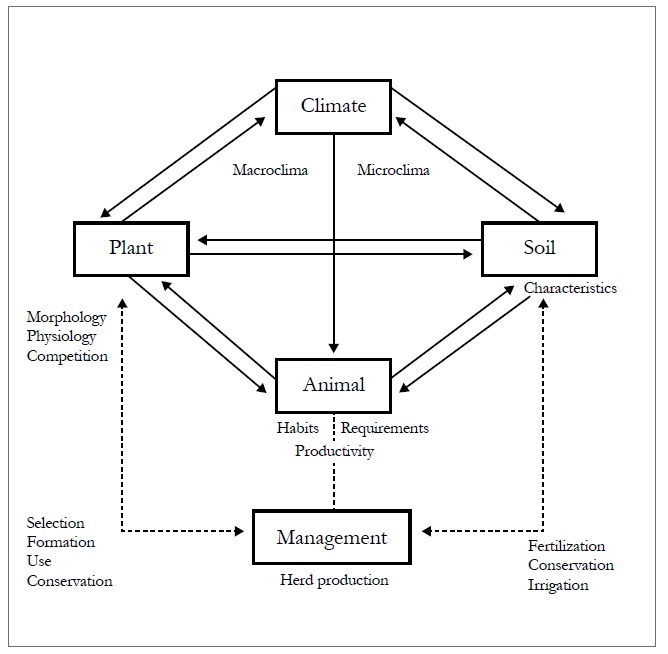
Source: Modified by Nascimento-Junior (1998)
Figure 2. Schematic representation of the interactions in a pasture ecosystem
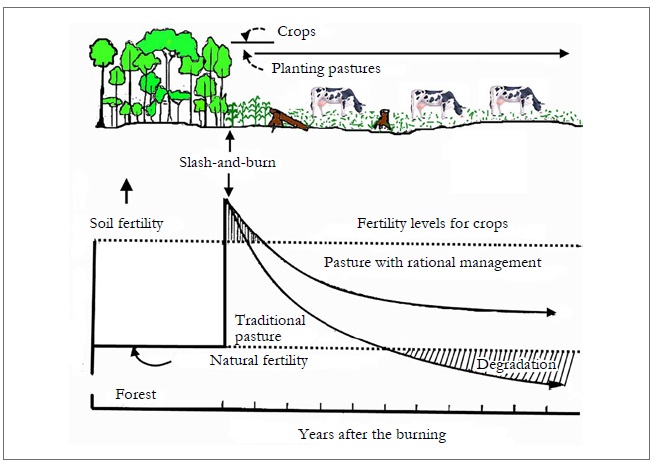
Source: modified by Townsend et al. (2010)
Figure 3. The process of forest to pasture conversion in the Amazon and its influence on the soil.
Rivas y Holman (1999) found in the department of Caquetá, located in the Colombian Amazon region the following types of pastures: naturalized (Axonopus compressus, Homolepsis aturensis, and Paspalum notatum), Arachis pintoi (pinto peanut, alone and in different types of associations), Axonopus micay, A. scoparius (imperial Crapet grass, imperial grass), Brachiaria brizantha, B. decumbens, B. dictyoneura, B. humidicola, B. mutica (Para grass), B. plantaginea, B. radicans (these last two are known in the area as braquipará), B. ruziziensis, Digitaria decumbens (Pangola grass), Hyparrhenia rufa ( Jaragua grass), Pennisetum purpureum (elephant grass), Panicum maximum (Guinea grass, buffalograss), Pueraria phaseoloides (kudzu), as well as associations between Brachiarias, and associations of Brachiarias with crawling legumes such as A. pintoi, Desmodium spp., and Pueraria spp. Likewise, these authors reported an increase in the areas dedicated to the implementation of pastures of the Brachiaria genus and the reduction of naturalized pastures.
However, the use of inadequate management practices, such as burning, the implementation of meadows composed only of grasses, the scarce use of trees and shrubs to conserve soil features, the use of slightly aggressive grass species of low competition with low resistance to shade and susceptible to plagues, and poor nutrient soils, generate low sustainability of the pastures and low animal productivity in the Amazon region (Grijalva, Ramos, & Vera, 2011).
Despite the low productivity of tropical grasses in the Amazon, the use of pastures that include forage species with the association of legumes implies additional nitrogen inputs that increases grass quality, favors mineralization processes, increases the support capacity of the meadow and prolongs its productive capacity, improving the nutritional value of the pasture and the response of the animal (Steinwandter et al., 2009). In addition, improved pastures in association with silvopastoral systems are a better option than traditional systems (extensive and monoculture) from the point of view of productivity and of the contribution to the conservation of the natural resources and the well-being of families, by reducing the impact of livestock on the environment (Benavides, 2011).
Sustainability applied to pastures
For Shakoor (2008), the sustainability of agroecosystems refers to the capacity of the system to maintain its productivity despite economic and natural disturbances, external or internal, satisfying present needs without harming future generations. Sustainability is a function of the interrelation of the natural characteristics of the system and the pressures and interventions it suffers, as well as social, economic and technical interventions that are made to counteract negative pressures, highlighting the resilience of the system (Martínez-Castillo, 2009). In this sense, a sustainable agroecosystem is one that has the following attributes: productivity, stability, reliability, resilience, adaptability, equity, and self-sufficiency (Larrea, 2011; Masera, Astier, & López, 1999).
Although there are broad and clear concepts about the sustainability of production systems, the definition of sustainable pasture is not yet consistent with the concept of sustainability. For example, Sánchez and Ara (1991) are the primary and only reference in the definition of sustainable pastures for authors as Castro (2013), Clavijo (2015), Ríos-Atehortúa (2010) and Sierra (2005). In these works, the authors affirm that sustainability in the pastures is the capacity of this ecosystem to supply livestock products in high and stable volumes over time, which are at the same time economically profitable and do not produce adverse effects on the environment, but conserve or improve the natural resources for the future generations. This can be translated into the ability of the system to maintain productivity when subjected to a major disturbing force such as pests, diseases, erosion problems, overgrazing, among others.
However, the previous definition does not include the social and technological components that are essential to achieve sustainability. Likewise, Hogdson and Silva (2000), attracted the attention to consider sustainability in a strict sense, with an emphasis on the maintenance of productivity and stability as the main goals of idealized management practices, even though it restricts the understanding of sustainability to the economic and ecological pillars typical of pasture productivity.
According to Giraldo (1993), a pasture is sustainable when it maintains coverage and guarantees nutrient recycling while maintaining soil fertility. However, for Casimir and Rao (1998), a pasture is sustainable if there is a balance between the first trophic level (pastures), the consumers of the second trophic level (herbivores), and the consumers of the third trophic level (humans), where the populations densities of both plants and herbivores remain relatively constant, and the consumption does not exceed the primary productivity of plants. Similarly, Sherren, Fischer, Clayton, Schirmer, and Dovers (2010), state that a sustainable pasture should consider practices that will balance production objectives with social values and ecological needs. Therefore, the last two authors approach the concept more holistically and appropriately to the concept of sustainability.
Furthermore, some authors consider that a sustainable pasture is one based on practices and technologies such as tillage and adequate land use practices (Zuazo, Pleguezuelo, Flanagan, Tejero, & Fernández, 2011); rational grazing with efficient combination of days of occupation and rest ( Jose et al., 2017; Osechas & Becerra, 2009); the combination of grasses with legumes (Shelton, Franzel, & Peters, 2005); free from weeds, with resistance to diseases and pests (Shakoor, 2008; Smith, Winograd, Gallopin, & Pachico, 1998); with sustained production, resilient and adaptable to different environmental situations (Volaire, Barkaoui, & Norton, 2014); with adjusted animal loads that avoid overgrazing and reduce degradation (O'Reagain, Scanlan, Hunt, Cowley, & Walsh, 2014), and economically viable (Kato, 2014), where silvopastoral systems are the path to better sustainable management principles ( Jose et al., 2017).
As stated by Russo (2015), silvopastoral systems (sps) are the product of the relationship between biology, society, and culture; however, ambiguity has favored the emergence of "discursive traps" deployed from complex and dense concepts such as sustainability. To that effect, some authors such as González and Alcaraz (2013), Jose et al. (2017), Rueda et al. (2011) and Zepeda, Velasco, Nahed, Hernández, and Martínez (2016) consider the SPS as sustainable production systems. However, although there are technologies such as agroforestry where SPS are framed, these are implemented for sustainable management (Wairiu, 2017). For this reason, SPS should not be considered as sustainable systems, but rather as tools to achieve the sustainability of pastures and, therefore, of the agroecosystems that contain them.
In pasture-based animal production systems, both forage production and the persistence of forages are important factors in the sustainability of these systems; the permanence of the pastures depends on the capacity of the plants to renew their dead stems and maintain a stable population density (Ramírez et al., 2011), as well as the grazing pressure to which it is subjected. However, Giraldo (1993) and Sánchez and Ara (1991) consider that the most important component in the sustainability of pastures is the maintenance or improvement of the physical and chemical soil characteristics. Therefore, it is necessary to return to the soil the nutrients removed by animal extraction or by the losses caused by washing and erosion.
Nonetheless, resilience is an essential factor in sustainability. It is defined as the ability of the system to maintain its integrity or return to a stability point after suffering an alteration due to internal or external causes. According to the conclusion stated by Anderies et al. (2002), a resilient system depends heavily on ecological, economic and management parameters. In this sense, sustainable pastures should conserve ecological resources such as soil, water, and biodiversity, in addition to maintaining producer income levels, which will depend on the application and appropriation of technologies and social intervention in pasture management.
According to Alves, Madari and Boddey (2017), the integration of forestry, livestock and agricultural systems is a strategy that will allow sustainability to be achieved, because these generate more eco-efficient systems, and it is necessary for integrated pastures to evaluate greenhouse gas emissions, especially N2O and CH4.
Bearing in mind that there is no clear definition of a sustainable pasture, we considered necessary to propose one, taking into account the previously stated definitions and the perception of the authors about a sustainable pasture, as follows:
Therefore, a sustainable pasture is an anthropized ecosystem that must provide livelihoods, produce benefits to the soil and plants, as well as well-being to animals and to the family, from the use and rational management of the soil to allow nutrient recycling and avoid its biological degradation, for the supply of plant and animal products in stable volumes over time with appropriate management practices (Voisin rational grazing), as well as with the association of grasses, legumes, shrubs and trees that allow resilience, productivity, and stability between producer and consumer organizations and, at the same time, conserve or improve natural resources for present and future generations, providing profitability to ensure the livelihood and well-being of the family (figure 4).
Indicators and metrics for the evaluation of sustainability in humid tropical pastures
Achieving sustainability is increasingly difficult requiring new ways of thinking and carrying out research work in pastures (Sollenberger, 2008). According to Gamboa-Tabares et al. (2009b), to address the evaluation of sustainability, multidimensionality must be considered, covering four primary dimensions: ecological, economic, social and technical. However, according to Smith et al. (2017), in recent years metrics have been developed for the evaluation of the sustainable intensification of agroecosystems, based on five domains: productivity, economic, environmental, social and human well-being.
Bearing in mind that the evaluation of sustainability in agroecosystems should be based on clear objectives framed in the need for analysis, and that to date processes like the implementation of silvopastoral systems with a sustainable pasture are frequently confused, the use of indicators and metrics is proposed for the valuation of sustainable pastures in the tropics from several domains or dimensions: productivity (table 2), economic (table 3), human well-being (table 4), environmental (table 5), and social (table 6), based on the compilation made by Smith et al. (2017) for the evaluation of the sustainable intensification of agroecosystems. Also, the indicators proposed by Domínguez-Hernández (2013), Gamboa-Tabares et al. (2009a), González (2009), Ramírez et al. (2008) and Tommasino, García, Marzaroli and Gutierrez (2012), are incorporated with a scope on pastures.
Table 2. Productivity indicators and metrics to assess the sustainability of pastures in the tropics
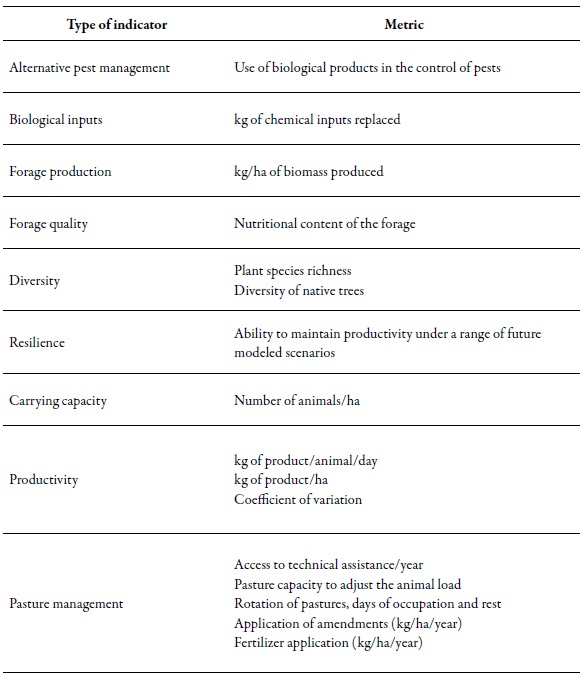
Source: Elaborated by the authors based on Domínguez-Hernández (2013), Gamboa-Tabares et al. (2009a), González(2009), Ramírez et al. (2008) and Smith et al. (2017)
From table 2, some indicators and metrics of theproductivity domain are compatible with the environmentaldomain, as is the case of diversity. Also, theseindicators are comparable with the indicators ofthe technical dimension addressed by Gamboa-Tabares et al. (2009b).
Table 3. Economic indicators and metrics to evaluate the sustainability of pastures in the tropics
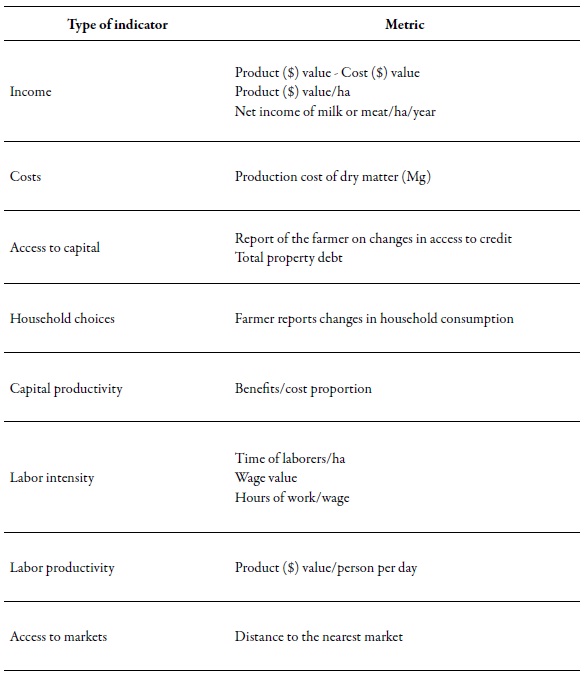
Source: Elaborated by the authors based on Gamboa-Tabares et al. (2009a), González (2009), Ramírez et al. (2008), Smith etal. (2017), and Tommasino et al. (2012)
Of the indicators and metrics related in table 3,household choices are functional for the socialdomain or dimension; similarly, capital productivityis functional for the productivity domain.
Table 4. Human well-being indicators and metrics to evaluate the sustainability of pastures in the tropics
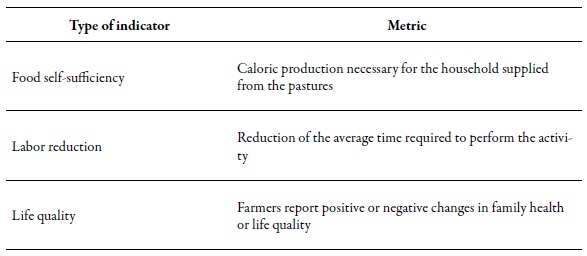
Source: Elaborated by the authors based on Smith et al. (2017)
Of the indicators and metrics related in table 4, thereduction of the average time required for pastureactivity should be reflected in food self-sufficiency,(Continue on next page)since the time not used in an activity should allowthe investment of this amount of time in other foodproduction activities other than pastures.
Table 5. Environmental indicators and metrics to evaluate the sustainability of pastures in the tropics
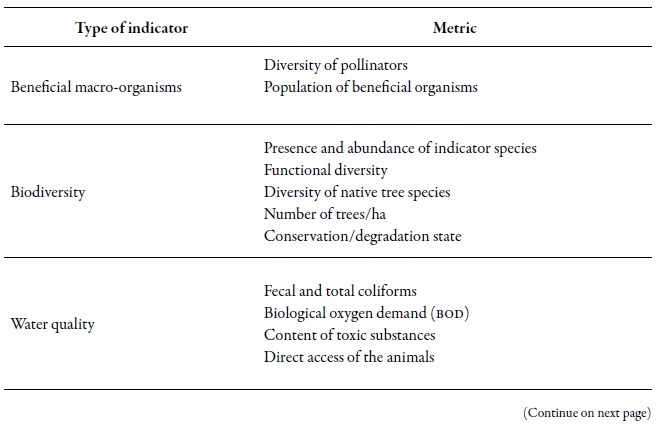
Source: Elaborated by the authors based on Domínguez-Hernández (2013), Gamboa-Tabares et al. (2009a), González(2009), Ramírez et al. (2008), Smith et al. (2017) and Tommasino et al. (2012).
Table 5 (cont.) Environmental indicators and metrics to evaluate the sustainability of pastures in the tropics
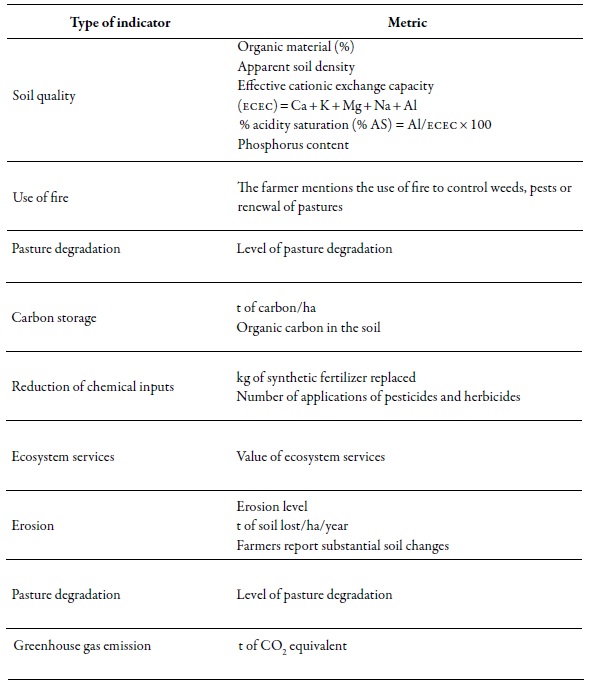
Source: Elaborated by the authors based on Domínguez-Hernández (2013), Gamboa-Tabares et al. (2009a), González(2009), Ramírez et al. (2008), Smith et al. (2017) and Tommasino et al. (2012).
Table 6. Social indicators and metrics to evaluate the sustainability of pastures in the tropics
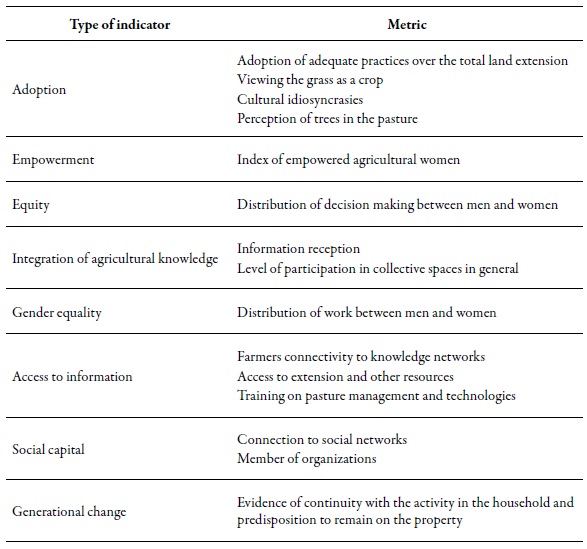
Source: Elaborated by the authors based on Domínguez-Hernández (2013), Gamboa-Tabares et al. (2009a), González (2009),Ramírez et al. (2008), Smith et al. (2017) and Tommasino et al. (2012).
From table 5, the set of environmental indicators and metrics that allow an evaluation focused on sustainability is broad; however, as mentioned, it is not necessary to address the entire resource base for a sustainability measurement, but rather choose those that are most sensitive to the system and to the context that will be evaluated.
Smith et al. (2017) argue that the indicators and associated metrics are overwhelmingly static, so they recommend more dynamic points of view to assess sustainability. It should be clarified that indicators and metrics related in their work should be adjusted to the objectives and context of analysis of each agroecosystem, and should be used in analytical, systemic or normative sustainability assessment frameworks, as reported by Sánchez-Fernández (2009).
The measurement of sustainability focused on pastures is proposed to be carried out considering that this is a subsystem framed in the livestock agroecosystem; therefore, if the subsystem is unsustainable, so will the system. In this sense, for the case of the tropics, it is suggested that the indices and metrics should be applied to evaluate the sustainability of livestock agroecosystems based on pasture sustainability when at least one of these two cases is met: 1) if the pasture subsystem represents more than 30 % of the total area of the agroecosystem, and 2) if the pastures generate more than 40% of the gross income of the family through the production of milk or meat.
However, the conclusions of the sustainability evaluation based on pastures in diversified systems must be made taking into account the context, so that, if the pasture subsystem is unsustainable, so will the system; however, if it is sustainable, the other subsystems should be analyzed. In the case of livestock agroecosystems in the Amazon and in the Colombian-Venezuelan plains, where pastures represent more than 60 % of the land and are the main source of economic income, the results of the measurement can be extrapolated to the complete system.
Conclusions
Sustainability is a current concept with a comprehensive development of frameworks, indicators, and metrics to measure both the stability and the social, economic and ecological harmony of agroecosystems, making it possible to measure the sustainability of the agroecosystems of the tropics with a focus on pastures. In addition, there is significant progress in the development and implementation of tools for the efficient management of pastures in tropical conditions, such as silvopastoral systems, rational grazing and ecological restoration of pastures, which should be understood as a mean and not as an end, in search of the always complex and arduous path of sustainability.
Likewise, it must be understood that a sustainable pasture in the tropics must meet at least 12 conditions. Among these, we include providing benefits to the soil and plants, welfare for the animals and providing both profitability and livelihoods to the producer family through appropriate management practices that allow the supply of stable products over time, the resilience of the pasture system, that it conserves or improves natural resources, as well as plant biodiversity for present and future generations.
Disclaimers
The current article was developed as part of the literature review carried out for a Master’s degree thesis. The authors declare that there are no conflicts of interest that jeopardize the validity of the results of this article, and in which there are significant contributions from all the authors, who agree with its publication.
Acknowledgments
The main author wishes to thank the government of the department of Huila and Colciencias for financing his Master’s degree studies through the Call No. 677 of 2014 for the formation of highlevel human capital in the department of Huila.
REFERENCES
Alves, B., Madari, B., & Boddey, R. (2017). Integrated crop- livestock-forestry systems: prospects for a sustainable agricultural intensification. Nutrient Cycling in Agroecosystems, 108(1), 1-4. doi: 10.1007/s10705-017-9851-0. [ Links ]
Anderies, J., Jansen, M., & Walker, B. (2002). Grazing management, resilience, and dynamics of a fire-driven rangelands systems. Ecosystems, 5(1), 23-44. doi: 10.1007/s10021-001-0053-9. [ Links ]
Benavides, R. (2011). Sostenibilidad de los sistemas ganaderos localizados en el parque nacional natural de las Hermosas y su zona de influencia, (Tesis de maestria). Universidad Nacional de Colombia, Palmira, Colombia. Recuperado de https://www.bdigital.unal.edu.co/3701/1/7408508.2011.pdf [ Links ]
Bonnefón, P. (2016). Indicadores de sustentabilidad ambiental y biodiversidad asociada a sistemas ganaderos (trabajo de grado). Universidad Nacional del Centro de la Provincia de Buenos Aires, Tandil, Argentina. Recuperado de https://www.ridaa.unicen.edu.ar/xmlui/handle/123456789/553 [ Links ]
Canto, M., Jobim, C., Pagliarini, M., Pancera-Jr, E., Barth, N.A., ... Vizotto, B. (2010). A pecuária de corte no Paraná -desenvolvimento, caracterização e o papel das pastegens. Scientia Agraria Paranaensis, 9(3), 5-21. doi:10.1818/sap. v9i3.5257. [ Links ]
Casas-Cázares, R., González-Cossio, F., Martínez-Saldaña, T., García-Moya, E., & Peña-Olvera, B. V. (2009). Sostenibilidad y estrategia en agroecosistemas campesinos de los valles centrales de Oaxaca. Agrociencia, 43(3), 319-331. Recuperado de https://www.scielo.org.mx/scielo.php?script=sci_arttext&pid=S1405-31952009000300010&lng=es&tlng=es [ Links ]
Casimir, M., & Rao, A. (1998). Sustainable herd management and the tragedy of no Man´s Land: an analysis of west Himalayan pastures using remote sensing techniques. Human Ecology, 26(1), 113-134. doi:10.1023/A:1018 701001793. [ Links ]
Castro, A., Lourenço Jr, J. d., dos Santos, N. d., Monteiro, E., de Aviz, M., & Garcia, A. (2008). Sistema silvipastoril na Amazônia: ferramenta para elevar o desempenho produtivo de búfalos. Ciência Rural, 38(8), 2395-2402. doi:10.1590/S0103-84782008000800050. [ Links ]
Castro, M. (2013). Caracterización social, económica y ambiental de las producciones bovinas lecheras del municipio de Floresta (Boyacá) (trabajo de grado). Duitama, Colombia: Universidad Nacional Abierta y a Distancia. Recuperado de https://www.repository.unad.edu.co/handle/10596/760. [ Links ]
Clavijo, L. (2015). Implementación de tecnologías sostenibles para el incremento del rendimiento de las pasturas, (tesis de maestría). Universidad de las Fuerzas Armadas, Sangolquí, Ecuador. Recuperado de https://www.repositorio.espe.edu.ec/xmlui/handle/21000/12241 [ Links ]
Da Veiga, J., & da Veiga, D. (2004). Sistemas silvopastoriles en la Amazonia oriental. Recuperado de https://www.fao.org/wairdocs/lead/x6343s/x6343s00.htm. [ Links ]
Dias-Filho, M. (2011). Os desafios da produção animal em pastagens na fronteira agrícola brasileira. Revista Brasileira de Zootecnia, 40(suplemento especial), 243-252. [ Links ]
Dignam, B., O´Callaghan, M., Condron, L., Raaijmakers, J., Kowalchuk, G., & Wakelin, S. (2016). Challenges and opportunitues in harnessing soil disease suppressiveness for sustainable pasture production. Soil Biology Biochemistry, 95, 100-111. doi:10.1016/j.soilbio.2015.12.006. [ Links ]
Domínguez-Hernández, M. (2013). Propuesta para el manejo sustentable y bajo condiciones de inocuidad en sistemas de producción ovina. Revista Iberoamericana para la Investigación y el Desarrollo Educativo, (10), 1-19. Recuperado de https://www.ride.org.mx/1-11/index.php/RIDESECUNDARIO/article/viewFile/214/209 [ Links ]
Espinola, J., Plá, L., Montañez, E., Leyva, J., & Cáceres, V. (2017). Evaluación de la sustentabilidad del sistema agrícola de la comunidad Huapra (Perú). Revista Investigación Operacional, 38(1), 91-100. [ Links ]
Fernández, L., & Gutiérrez, M. (2013). Bienestar Social, Económico y Ambiental para las Presentes y Futuras Generaciones. Información Tecnológica, 24(2), 121-130. doi:10.4067/S0718-07642013000200013. [ Links ]
Gamboa-Tabares, J., Varela-Ramírez, O., Peraza-Padilla, W., León-González, R., Chávez-Vargas, H., & Obando-Contreras, C. (2009a). Diseño de una matriz de indicadores para evaluar la sostenibilidad de una finca en San José (Costa Rica). Momentos de Ciencia, 6(1), 32-42. Recuperado de https://www.udla.edu.co/revistas/index.php/momentosde-ciencia/article/view/175 [ Links ]
Gamboa-Tabares, J., Varela-Ramírez, O., Peraza-Padilla, W., León-González, R., Chávez-Vargas, H., & Obando-Contreras, C. (2009b). Cálculo de índices de sostenibilidad para una finca dedicada a la producción de café orgánico en San José (Costa Rica). Momentos de Ciencia, 6(1), 60-69. Recuperado de https://www.udla.edu.co/revistas/index.php/momentos-de-ciencia/article/view/179 [ Links ]
García, B. (2014). Competitividad de sistema de producción bovina de montaña SP4 como resultado de las prácticas de conocimiento local: el caso del corregimiento de Santo Domingo de Florencia-Caquetá (tesis de maestría). Pontificia Universidad Javeriana, Bogotá, Colombia. Recuperado de https://www.repository.javeriana.edu.co/handle/10554/12408 [ Links ]
García, S., Bienvenido, B., & Flores, P. (2009). Desarrollo de una página web integrando mapas conceptuales sobre indicadores de sostenibilidad. En B. Tolón, B. Lastra (Ed.), III seminario internacional de cooperación y desarrollo en espacios rurales iberoamericanos. Sostenibilidad e indicadores (pp. 335-345). Almería, España: Universidad de Almería. [ Links ]
García, Y., Ramírez, W., & Sánchez, S. (2012). Soil quality indicators: a new way to evaluate this resource. Pastos y Forrajes, 35(2), 125-138. [ Links ]
Giraldo, V. (1993). Manejo y utilización sostenible de pasturas. Medellín, Colombia: Universidad Nacional de Colombia. [ Links ]
González, P. (2009). Evaluación de tres sistemas silvopastoriles para la gestión sostenible de los recursos naturales de la microcuenca del río Chimborazo (trabajo de grado). Escuela Superior Politécnica Chimborazo, Riobamba, Ecuador. Recuperado de https://www.repositorio.educacionsuperior.gob.ec/bitstream/28000/955/1/P-SENESCYT-0025.pdf [ Links ]
González, P., & Alcaraz, V. (2013). Cultivo y costos de un sistema silvopastoril intensivo (SSPI) a base de gramíneas y Leucaena leucocephala: estudio de caso en Tepalcatepec, Michoacán, México. INCEPTUM, 8(15), 277-292. Recuperado de https://www.redalyc.org/articulo.oa?id=83728497004 [ Links ]
Grijalva, J., Ramos, R., & Vera, A. (2011). Pasturas para sistemas silvopastoriles: Alternativas para el desarrollo sostenible de la ganadería en la Amazonia baja de Ecuador. Quito, Ecuador: Instituto Nacional de Investigaciones Agropecuarias (Iniap). [ Links ]
Guedes, E., Fernandes, A., Lima, E. d., Gama, M., & da Silva, A. (2009). Fosfato natural de arad e calagem e o crescimento de Brachiaria brizantha em latossolo amarelo sob pastagem degradada na Amazônia. Ciências Agrárias/Amazonian Journal of Agricultural Sciences, 52(1), 117-129. [ Links ]
Hazard, L., Steyeart, P., Martin, G., Couix, N., Navas, M., Duru, M., ... Labatut, J. (2017). Mutual learning between researchers and farmers during implementarion of scientific principles for sustainable devopment: the case of biodiversitybased agriculture. Integrated Research System for Sustainable Development, 13(1), 1-14. doi:10.1007/s11625-017-0440-6. [ Links ]
Hogdson, J., & Silva, S. (2000). Sustainability of grazing system: goals, concepts and methods. En G. Lemaire, J. Hodgson, A. Moraes, P. Carvalho, & C. Nabinger (Eds.), Grassland ecophysiology and grazing ecology (pp. 1-14). Wallingford, Inglaterra: CAB International. doi:10.1079/ 9780851994529.0001. [ Links ]
Jose, S., Walter, D., & Kumar, B. (2017). Ecological considerations in sustainable silvopasture desing and management. Agroforestry Systems, 93(1), 1-15. doi:10.1007/s10457016-0065-2. [ Links ]
Juárez-Hernández, J., & Bolaños-Aguilar, E. (2007). Las curvas de dilución de la proteina como alternativa para la evaluación de pastos tropicales. Universidad y Ciencia, 23(1), 81-90. Recuperado de https://www.redalyc.org/articulo.oa?id=15423109 [ Links ]
Kato, S. (2014). Quantitative predictions for ecological and economic sustainability in Mongolian pastoral systems. En S. Sakai, & C. Umetsu (Eds.), Social-ecological systems in transition (pp. 107-119). Japan: Springer. doi:10.1007/ 978-4-431-54910-9_6. [ Links ]
Kroff, M., Bouma, J., & Jones, J. (2001). Systems approaches for the desing of sustainable agro-ecosystems. Agricultural Systems, 70, 369-393. doi:10.1016/S0308-521X(01)00052-X. [ Links ]
Larrea, A. (2011). Caracterización y eficiencia de la producción lechera en el noreste de la Pampa (Argentina) (tesis de doctorado). Universidad de Córdoba, Córdoba, España. Recuperado de https://www.europeana.eu/portal/en/record/2022701/oai_helvia_uco_es_10396_5219.html [ Links ]
Lindell, L., Åström, M., & Öberg, T. (2010). Land-use versus natural controls on soil fertility in the Subandean Amazon, Peru. Science of the Total Environment, 408, 965-975. doi:10.1016/j.scitotenv.2009.10.039. [ Links ]
Londoño, P. (2015). El enfoque de gobernanza en la evaluación del desarrollo sostenible a escala local (caso del departamento de Antioquia, Colombia). Revista Mexicana de Ciencias Agrícolas, 257-263. Recuperado de https://www.redalyc.org/articulo.oa?id=263139243035. [ Links ]
Mahecha, L., Gallego, L., & Peláez, F. (2002). Situación actual de la ganadería de carne en Colombia y alternativas para impulsar su competividad y sostenibilidad. Revista Colombiana de Ciencias Pecuarias, 15(2), 213-225. [ Links ]
Martínez-Castillo, R. (2009). Sistemas de producción agrícola sostenible. Tecnología en Marcha, 22(2), 23-39. Recuperado de https://www.revistas.tec.ac.cr/index.php/tec_marcha/article/view/114 [ Links ]
Martínez, S., Pedraza, R., Guevara, G., González, C., & León, M. (2009). Ordenamiento de 13 forrajes según su producción acumulada de gas in vitro con heces bovinas depuestas como inóculo. Revista de Producción Animal, 20(1), 21-24. [ Links ]
Masera, O., Astier, M., & López, S. (1999). Sustentabilidad y manejo de recursos naturales. El marco de la evaluación Mesmis. México D. F., México: Universidad Nacional Autónoma de México (UNAM). [ Links ]
Ministerio de Vivienda, Ordenamiento Territorial y Medio Ambiente de Uruguay. (2010). Diseño de un sistema de indicadores para el monitoreo del desarrollo sostenible a nivel nacional y costero en Uruguay. Montevideo, Uruguay: autor. [ Links ]
Nascimento-Junior, D. (1998). Ecossistemas de pastagens cultivadas. Simpósio sobre manejo de pastagens (pp. 271296). Piracicaba, Brasil: Fundação de Estudos Agrários Luiz de Queiroz. [ Links ]
Neves-Neto, D., dos Santos, A., & Neto, S. d. (2012). Atributos físicos e químicos do solo em ecossistema de campim- mombaça na Amazônia Oriental. Ciências Agrárias/ Amazonian Journal of Agricultural Sciences, 55(2), 75-84. doi:10.4322/rca.2012.041. [ Links ]
O'Reagain, P., Scanlan, J., Hunt, L., Cowley, R., & Walsh, D. (2014). Sustainable grazing management for temporal and spatial variability in north Australian rangelands -a synthesis of the latest evidence and recommendation. The Rangelands Journal, 36(3), 223-232. doi:10.1071/ RJ13110. [ Links ]
Osechas, D., & Becerra, L. (2009). Estrategias de manejo de pastizales para la producción sustentable en fincas doble propósito en el occidente de Venezuela. Bioagro, 21(2), 125-132. [ Links ]
Ramírez, L., Alvarado, A., Pujol, R., MaHugh, A., & Brenes, L. (2008). Indicadores para estimar la sostenibilidad agrícola de la cuenca media del río Reventado, Cartago, Costa Rica. Agronomía Costarricense, 32(2), 93-118. Recuperado de https://www.redalyc.org/articulo.oa?id=43632206. [ Links ]
Ramírez, R., da Silva, S., Hernández, G., Enríquez, Q., Pérez, P., Quero, C., & Herrera, H. (2011). Rebrote y estabilidad de la población de tallos en el pasto Panicum maximum cv Mombaza cosechado en diferentes intervalos de corte. Revista Fitotecnia Mexicana, 34(3), 213-220. [ Links ]
Rinehart, L. (2010). Producción de bovinos. Consideraciones para productores de carne y de leche basada en pastoreo. ATTRA. Recuperado de https://www.attra.ncat.org/attra-pub/summaries/summary.php?pub=331 [ Links ]
Ríos-Atehortúa, G. (2010). Propuesta para generar indicadores de sostenibilidad en sistemas de producción agropecuaria, para la toma de decisiones. Caso: lechería especializada (tesis de maestría). Universidad Nacional de Colombia, Medellín, Colombia. Recuperado de https://www.bdigital.unal.edu.co/1888/1/43097230.2010.pdf [ Links ]
Rivas, L., & Holman, F. (1999). Adopción temprana de Arachis Pintoi en el trópico húmedo: el caso de los sistemas ganaderos de doble propósito en Caquetá, Colombia. Pasturas Tropicales, 21(1), 2-17. [ Links ]
Romero, M. (2009). Desarrollo local a escala humana. Polis, 8(22), 137-158. Recuperado de https://www.journals.openedition.org/polis/2645 [ Links ]
Rueda, O., Cuartas, C., Naranjo, J., Córdoba, C., Murgueitio, E., & Anzola, H. (2011). Comportamiento de variables climáticas durante estaciones secas y de lluvia, bajo influencia del ENSO 2009-2011 (El Niño) y 2010-2011 (La Niña) dentro y fuera de sistemas silvopastoriles intensivos en el Caribe seco de Colombia. Revista Colombiana de Ciencias Pecuarias, 24(3), 512. [ Links ]
Russo, R. (2015). Reflexiones sobre los sistemas silvopastoriles. Pastos y forrajes, 38(2), 157-161. Recuperado de https://www.scielo.sld.cu/scielo.php?script=sci_arttext&pid=S0864-03942015000200001&lng=es&tlng=es [ Links ]
Sánchez, P., & Ara, M. (1991). Contribución potencial de las pasturas mejoradas a la sostenibilidad de los ecosistemas de sabana y de bosque húmedo tropical. En Contribución de las pasturas mejoradas a la producción animal en el trópico: Memorias de una reunión de trabajo (pp. 1-23). Cali, Colombia: Centro Internacional de Agricultura Tropical (CIAT). [ Links ]
Sánchez-Fernández, G. (2009). Análisis de la sostenibilidad agraria mediante indicadores sinteticos: aplicación empírica para sistemas agrarios de Castilla y León (tesis de doctorado). Universidad Politecnica de Madrid, Madrid, España. [ Links ]
Sarandón, S., & Flores, C. (2009). Evaluación de la sustentabilidad en agroecosistemas: una propuesta metodológica. Agroecología, 4, 19-28. [ Links ]
Sarmento, C., Veiga, J., Rischkowsky, B., Kato, O., & Siegmund-Schultze, M. (2010). Caracterização e avaliação da pastagem do rebanho de agricultores familiares do nordeste paraense. Acta Amazonica, 40(3), 415-424. doi:10.1590/S004459672010000300002. [ Links ]
Sepúlveda, C., Ibrahim, M., Bach, O., & Rodríguez, A. (2011). Desarrollo de lineamientos para la certificación de sistemas sostenibles de producción ganadera. Agroforestería de las Américas, 48, 14-20. Recuperado de https://www.bco.catie.ac.cr/portal-revistas/index.php/AGRO/article/view/88/0 [ Links ]
Shakoor, C. (2008). Forage based animal production systems and sustainability, ad invited keynote. Revista Brasileira de Zootecnia, 37(Suppl. Esp.), 78-84. doi:10.1590/S15 16-35982008001300010. [ Links ]
Shelton, H., Franzel, S., & Peters, M. (2005). Adoption of tropical legume technology around the world: analysis of success. En D. McGilloway (Ed.), Grassland: a global resource (pp. 149-166). Wageningen, Países Bajos: Wageningen Academic Publishers. Recuperado de https://www.hdl.handle.net/10568/55508. [ Links ]
Sherren, K., Fischer, J., Clayton, H., Schirmer, J., & Dovers, S. (2010). Integration by case, place and process: transdisciplinary research for sustainable grazing in the Lachlan River catchment, Australia. Landscape Ecology, 25(8), 1219-1230. doi:10.1007/s10980-010-9494-x. [ Links ]
Sierra, P. (2005). Fundamentos para el establecimiento de pasturas y cultivos forrajeros. Medellín, Colombia: Universidad de Antioquia. [ Links ]
Silva, R., Barioni, L., Hall, J., Moretti, A., Veloso, R., Alexander, P., ... & Morán, D. (2017). Sustainable intensification of Brazilian livestock production through optimized pasture restoration. Agriculural Systems, 153, 201-211. doi:10.1016/j.agsy.2017.02.001. [ Links ]
Smith, A., Snapp, S., Chikowo, R., Thorne, P., Bekunda, M., & Glover, J. (2017). Measuring Sustainable Intensification in Smallholder Agroecosystems: A Review. Global Food Security, 12, 127-138. doi:10.1016/j.gfs.2016.11.002. [ Links ]
Smith, J., Winograd, M., Gallopin, G., & Pachico, D. (1998). Dynamics of the agricultural frontier in the Amazon an savannas of Brazil: analyzing the impact of policy and technology. Environmental Modelling and Assessment, 3, 31-46. doi:10.1023/A:1019094218552. [ Links ]
Sollenberger, L. (2008). Sustainable production systems for Cynodon species in the subtropics and tropics. Revista Brasileira de Zootecnia, 37(Suppl. Esp.), 85-100. doi:10. 1590/S1516-35982008001300011. [ Links ]
Steinwandter, E., Olivo, C., dos Santos, J., Araújo, T., Aguirre, P., & Diehl, M. (2009). Produção de forragem em pastagens consorciadas com diferentes leguminosas sob pastejo rotacionado. Acta Scientarum. Animal Sciences, 31(2), 131-137. doi:10.4025/actascianimsci.v31i2.6238. [ Links ]
Stewart, B., Lal, R., & El-Swaify, S. (1991). Sustaining the resource base of an expanding world agriculture. En R. Lal, & F. Pierce (Eds.), Soil management for sustainable (pp. 125-144). Iowa, EE. UU.: Soil and Water Conservation Society. [ Links ]
Tellarini, V., & Caporali, F. (2000). An Input/output metho- dology to evaluate farms as sustainable agroecosystems: an application of indicators to farms in central Italy. Agriculture Ecosystems Environment, 77(1-2), 111-123. doi:10.1016/S0167-8809(99)00097-3. [ Links ]
Tommasino, H., García, F., Marzaroli, J., y Gutierrez, R. (2012). Indicadores de sustentabilidad para la produccion lechera familiar en Uruguay: análisis de tres casos. Agrociencia Uruguay, 16(1), 166-176. [ Links ]
Townsend, C., Costa, N., & Pereira, R. (2010). Aspectos econômicos da recuperação de pastagens no bioma Amazônia. Pubvet, 4(14), 1-31. [ Links ]
Triana, G., Curbelo, R., & Loyola, H. (2017). Indicadores bioeconómicos del uso de Ataleia cubensis (DC) Dietr. para la producción con rumiantes en Camagüey. Revista de producción Animal, 29(1), 16-20. [ Links ]
Vásquez, L. (2008). Conocimiento local de plantas herbáceas y leñosas forrajeras en dos localidades del municipio de Muy Muy, Matagalpa, Nicaragua. Revista de Desarrollo Rural y Cooperativismo Agrario, 11, 159-170. [ Links ]
Volaire, F., Barkaoui, K., & Norton, M. (2014). Designing resilient and sustainable grassland for a drier future: adaptative strategies, funtional traits and biotic interactions. European Journal of Agronomy, 52(B), 81-89. doi:10.1016/j. eja.2013.10.002. [ Links ]
von Bernard, H. T. (2006). Sustentabilidad de la producción ganadera bovina. ¿Es posible internalizar los costos ambientales? Un estudio en la pampa húmeda (tesis de maestría). Universidad de Buenos Aires, Buenos Aires, Argentina. Recuperado de https://www.catalogosuba.sisbi.uba.ar/vufind/Record/http%253A%252F%252Fwww.agro.uba.ar%252Fusers%252Frins%252Fagrotesi%252F015980 [ Links ]
Wairiu, M. (2017). Land degradation and sustainable land management practices in Pacific Island Countries. Regional Environmental Change, 17(4), 1053-1064. doi:10.1007/ s10113-016-1041-0. [ Links ]
Zepeda, C., Velasco, Z., Nahed, T., Hernández, G., & Martínez, T. (2016). Adopción de sistemas silvopastoriles y contexto sociocultural de los productores: apoyos y limitantes. Revista Mexicana de Ciencias Pecuarias, 7(4), 471-488. doi:10.22319/rmcp.v7i4.4282. [ Links ]
Zuazo, V., Pleguezuelo, C., Flanagan, D., Tejero, I., & Fernández, J. (2011). Sustainable land use and agricultural soil. En E. Lichtfouse (Ed.), Alternative farming systems, biotechnology drought stress and ecological fertilisation, sustainable (pp. 107-192). Ámsterdam, Países Bajos: Springer. [ Links ]
Received: June 04, 2017; Accepted: February 18, 2019











 text in
text in 


